Development of the economic activity of the population - 2. quarter of 2005
Product Code: e-3133-05
Development of the economic activity of the population in the 2nd quarter of 2005
Employment in the primary sector (agriculture, forestry, fishing) decreased to 194.8 thousand persons and accounted for only 4.1% of the total number of first (main) job holders. The number of persons employed in the secondary sector (industry, construction) increased by 33.9 thousand year-on-year to 1 873.7 thousand (39.4% of total employment). This growth is mainly attributed to the increase of +35.3 thousand in employment that occurred in construction. The number of employed persons went up most in building and civil engineering (+25.1 thousand) and building installations (+9.7 thousand). ‘Manufacturing’ recorded a total increase of 12.8 thousand, most in ‘treatment and coating of metals; general mechanical engineering’ (+12.7 thousand), followed by ‘manufacture of machinery for production and use of mechanical power, except aircraft, vehicle and cycle engines’ (+6.0 thousand), ‘manufacture of electric motors, generators and transformers’ (5.8 thousand), and ‘manufacture of parts and accessories for motor vehicles and their engines’ (+5.2 thousand). The decrease in the employment in ‘mining and quarrying’ (-15.3 thousand) was a result of a decrease in the number of workers in ‘mining and agglomeration of hard coal’ in particular (-9.3 thousand).
Employment in the tertiary sector (all branches of services, including transport) increased by 28.6 thousand to 2 680.5 thousand (56.4% of total employment), developing in the individual branches in an opposing way. It increased most in ‘education’ (+13.5 thousand), ‘public administration and defence; compulsory social security’ (+13.2 thousand) and ‘health and social care’ (+12.3 thousand). Within the category ‘education’, it grew most in ‘primary education’ (+8.9 thousand), especially in Prague (+6.2 thousand) and within the category ‘public administration and defence; compulsory social security’, the number of people employed in ‘administration of the State and the economic and social policy of the community‘ increased by 12.5 thousand. In this area, general activities of the administration of the State intensified, especially at the level of regional and local authorities, mainly in the Středočeský, Jihomoravský and Moravskoslezský Regions. And in these regions the number of persons included in this group was smaller in 2004 than in 2003 or 2002 as indicated by LFSS results. Within the category ‘health and social work’, the growth was seen especially in ‘human health activities’ (+8.8 thousand).
On the other hand, the employment dropped most year-on-year in ‘wholesale and retail trade; repair of motor vehicles, motorcycles and personal and household goods’ (-15.3 thousand; primarily in ‘retail sale in non-specialized stores’: -18.7 thousand). It dropped in ‘transport, storage and communications’ (-7.3 thousand; most in ‘transport via railways’: -4.8 thousand). A considerable decrease in the number of employed people was recorded for ‘real estate; renting and business activities’ (-3.5 thousand; most in ‘letting of own property’: -5.4 thousand).
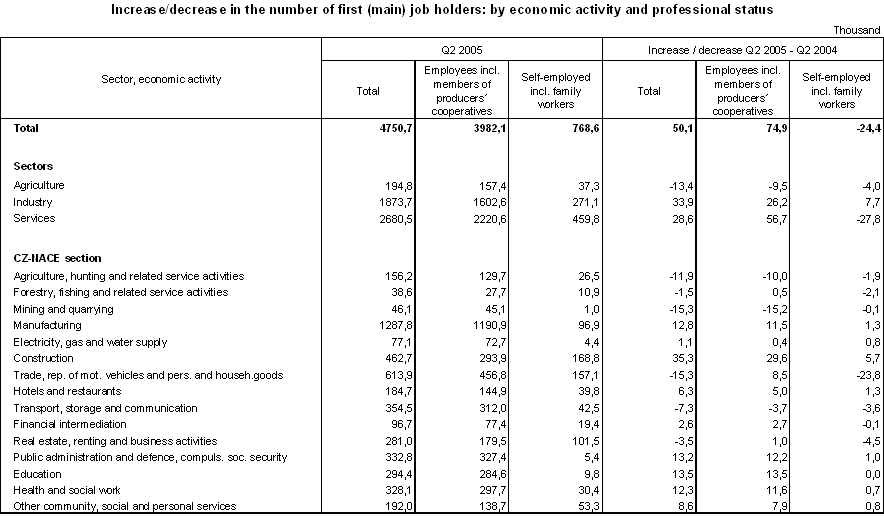
Decreases in the self-employed occurred most in services, first of all in trade. Year-on-year decreases in the number of self-employed persons, including contributing family workers, were biggest in ‘retail sale in non-specialized stores’ (-6.6 thousand), ‘retail sale not in stores’ (-4.8 thousand), ‘software consultancy and supply’ (-4.8 thousand), ‘maintenance and repair of motor vehicles’ (-3.5 thousand), ‘other retail sale of new goods in specialized stores’ (-3.5 thousand), repair of personal and household goods (-3.3 thousand), and advertising (-3.2 thousand). The falling total number of persons in self-employment since early 2004 is due to the falling number of the self-employed in ‘trade, repairs of motor vehicles and personal and household goods’.
The total employment rate of persons aged 15-64 grew year-on-year by 0.5 percentage points to 64.7%. The relative increase in the employment of men at working age was especially high (+1.1 percentage points to 73.3%), while in women it remained virtually at the level recorded a year ago (an increase to 56.0%). This employment rate is pushed down by a fast growth of the number of students at secondary schools on the one hand and pushed up by the employment of persons aged between 25 and retirement age 55-64 on the other hand.
In this very group of persons aged 55-64, the employment rate rose year-on-year more than in any other age group of person throughout the whole working age interval (compared to Q2 2004 by 1.7 points to 44.2%). Compared internationally, the employment rate of these older employed persons keeps increasing in the total of all the 25 member states of the EU. It increased in the EU-25 from 35.8% in 1998 to 40.5% in 2004. Employment in EU-15 is relatively higher––it went up by 5.3 percentage points to 41.9% over the same period.
Differences among individual states are considerable: on the one hand, there are nine countries where the employment in this age group does not reach even a third of the number of these persons––Austria, Belgium, Hungary, Italy, Luxembourg, Malta, Poland, Slovenia, and Slovakia)––and, on the other hand, more than half of the persons of this age worked in seven countries in 2004––Cyprus, Denmark, Estonia, Finland, Portugal, Sweden (69.1%!), and the UK).
The employment rate in the CR is above-average and is higher than in Germany and substantially higher than in the other three neighbouring countries. However, the higher rate of employment is affected by the employment of men, while the employment of women of this age is below the average for both the EU-15 and the EU-25.
In the long run, the growth of the employment rate in the CR was faster than in the EU-25 or the EU-15 (5.6 percentage points as against 4.7 percentage points in the EU-25 or 5.3 percentage points in the EU-15 between 1998-2004). In some countries, however, the increment in the unemployment rate was considerably higher than in the CR (e.g. by 14.7 percentage points in Finland and by 13.8 percentage points in Hungary).
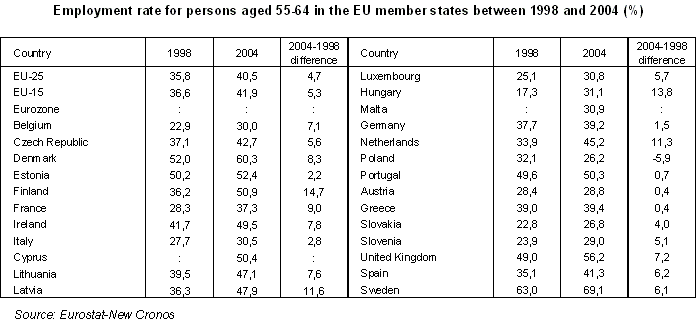
The employment rate of men and women aged 55-64 was steadily rising in the CR between 1998 and 2004, except for 2000, that of women growing faster in relative terms.
Nevertheless, the Czech Republic still belongs to the countries where the employment rate of men in this age group is notably higher than that of women of the same age. In 2004, the difference between the two employment rates in the CR was 27.8 percentage points (57.2% for men and 29.4% for women; in Q2 2005 it was 59.1% and 30.6%, respectively). The CR thus ranked among seven EU member states with the biggest differentiation of the rate by gender. This difference is primarily brought about by the different retirement age. Only the Mediterranean countries Greece, Spain, Cyprus and Malta and then Slovakia and Ireland report a bigger gender difference in these rates.
Employment rate for men and women aged 55-64 in the EU member states in 2004
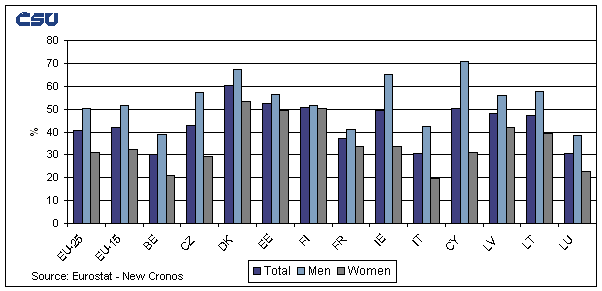
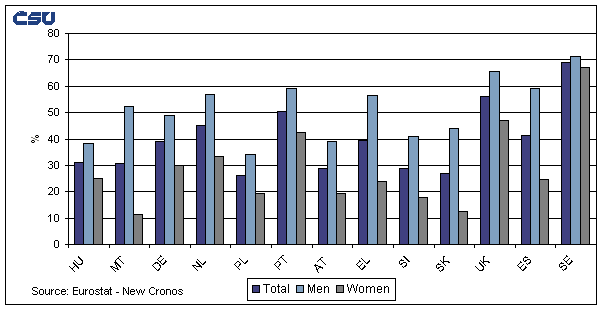
The employment of persons living in the individual regions of the Czech Republic dropped year-on-year in four of them, absolutely most in the Zlínský and Liberecký Regions. On the other hand, the number of employed persons increased most in the Moravskoslezský Region, which suffers from high unemployment chronically, the Hl. m Praha Region and the Plzeňský Region.
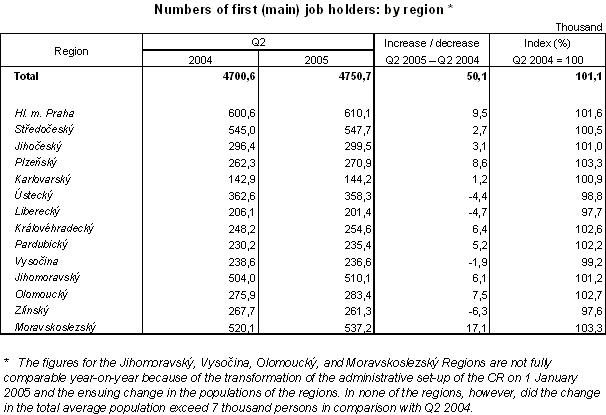
With the growing total employment of the residing population, the economically inactive also increased in number, while the number of the unemployed decreased (all year-on-year). The number of unemployed persons (ILO methodology) decreased by 17.0 thousand year-on-year to reach 402.1 thousand in Q2 2005 on average. The number of the unemployed decreased in most of the five-ear groups of working age persons; it decreased substantially in the group of persons aged 20-24, namely by 15.2 thousand. The number of unemployed men (180.2 thousand) is still below the number of unemployed women (221.9 thousand). With the total year-on-year drop in unemployment, the unemployment of men decreased by 20.0 thousand, and the decrease was the biggest in the group of 20-24-year-old persons (-10.9 thousand). Over the same period, the number of unemployed women increased by 3.0 thousand in total, and this increase occurred practically in the whole working age interval (15-64 years), despite a decrease in the number of unemployed women aged 20-24.
The number of persons unemployed for a long time (1 year or more) fell by 3.3 thousand. Despite this general drop in the long-time unemployed, increases in the long time unemployed young men aged 15-19 (+1.9 thousand), men aged 40-49 (+1.3 thousand) and women aged 50-59 (+3.0 thousand) are alarming.
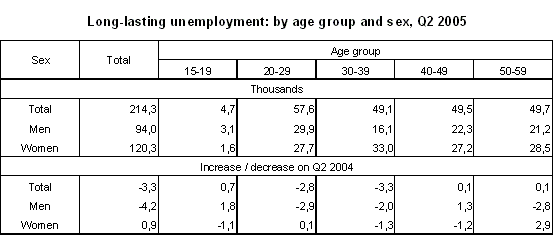
The number of the unemployed with basic education decreased by 4.8% year-on-year to 100.0 thousand and that of the unemployed with secondary education without GCSE (with secondary vocational education in particular) decreased by 7.6% to 191.5 thousand. The number of the unemployed with secondary and higher educational attainment increased a bit, but their unemployment is lower in comparison with the above two groups. The number of the unemployed having secondary education with GCSE grew by 2.8% to 95.2 thousand and the number of unemployed university graduates by 9.3% to 15.3 thousand.
Year-on-year, the unemployment dropped most in the Olomoucký, Královéhradecký and Jihomoravský Regions; the situation got worse especially in the Ústecký and Zlínský Regions.
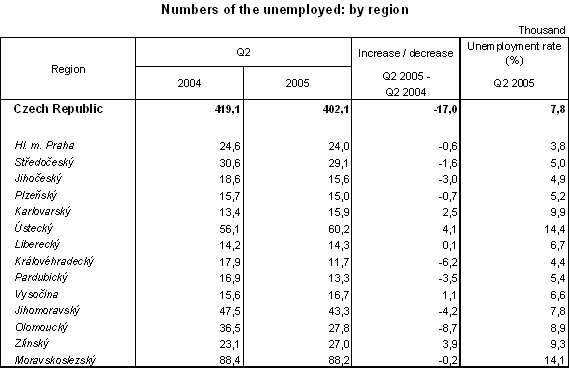
The growth of total employment and the decrease in the number of unemployed persons brought about a relatively high decrease in general unemployment rate. Compared to Q2 2004, the general unemployment rate decreased by 0.4 percentage points to 7.8%. It decreased in the male population only (by 0.8 percentage points to 6.3%) and in women it increased by 0.1 percentage point to 9.8%.
The number of economically inactive persons aged 15+ (according to the LFSS methodology they are persons who had no job and were not seeking any job during last four weeks or failed to meet all conditions for being classified among the unemployed) increased by 4.5 thousand in a year and reached 3 552.3 thousand in Q2 2005. This category is primarily affected by numbers of the retired and of persons preparing for their future occupation. Basic school pupils decreased by 8.2 thousand in number. While the number of apprentices decreased by 5.4 thousand, the number of secondary school pupils went up by 14.2 thousand to 390.5 thousand. The number of university students also including higher professional school students grew rapidly, by 22.2 thousand, to 249.4 thousand. The number of economically inactive, normally retired persons not seeking any job actively increased by 1.9 thousand to 1 821.2 thousand and the number of persons in early retirement fell by 3.3 thousand to 71.6 thousand. Furthermore, the number of disability pensioners increased by 6.2 thousand to 309.0 thousand. These figures cannot accurately correspond to the statistics on pupils and students compiled by the Ministry of Education, Youth and Sports of the CR or to the numbers of pensioners on the records of the Ministry of Labour and Social Affairs of the CR because the pupils, students or pensioners who qualified for being classified among persons in employment or unemployment in the reference week are not reported as economically inactive.
